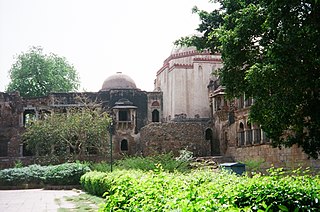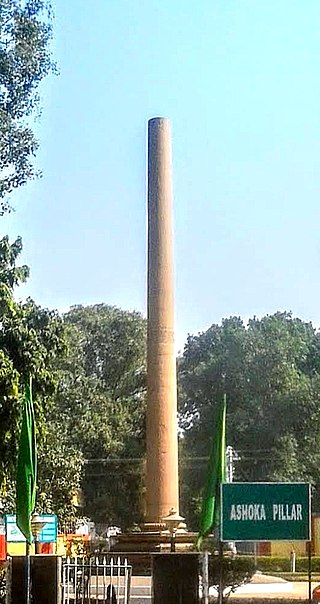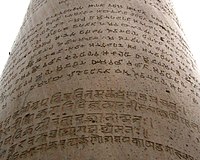
Ashoka, popularly known as Ashoka the Great, was the third Mauryan Emperor of Magadha in the Indian subcontinent during c. 268 to 232 BCE. His empire covered a large part of the Indian subcontinent, stretching from present-day Afghanistan in the west to present-day Bangladesh in the east, with its capital at Pataliputra. A patron of Buddhism, he is credited with playing an important role in the spread of Buddhism across ancient Asia.

The Edicts of Ashoka are a collection of more than thirty inscriptions on the Pillars of Ashoka, as well as boulders and cave walls, attributed to Emperor Ashoka of the Maurya Empire who reigned from 268 BCE to 232 BCE. Ashoka used the expression Dhaṃma Lipi to describe his own Edicts. These inscriptions were dispersed throughout the areas of modern-day Bangladesh, India, Nepal, Afghanistan and Pakistan, and provide the first tangible evidence of Buddhism. The edicts describe in detail Ashoka's view on dhamma, an earnest attempt to solve some of the problems that a complex society faced. According to the edicts, the extent of Buddhist proselytism during this period reached as far as the Mediterranean, and many Buddhist monuments were created.

The pillars of Ashoka are a series of monolithic pillars dispersed throughout the Indian subcontinent, erected—or at least inscribed with edicts—by the 3rd Mauryan Emperor Ashoka the Great, who reigned from c. 268 to 232 BC. Ashoka used the expression Dhaṃma thaṃbhā, i.e. "pillars of the Dharma" to describe his own pillars. These pillars constitute important monuments of the architecture of India, most of them exhibiting the characteristic Mauryan polish. Twenty of the pillars erected by Ashoka still survive, including those with inscriptions of his edicts. Only a few with animal capitals survive of which seven complete specimens are known. Two pillars were relocated by Firuz Shah Tughlaq to Delhi. Several pillars were relocated later by Mughal Empire rulers, the animal capitals being removed. Averaging between 12 and 15 m in height, and weighing up to 50 tons each, the pillars were dragged, sometimes hundreds of miles, to where they were erected.

Karuvaki was the "Second queen consort" of the third Mauryan emperor, Ashoka. She was Ashoka's wife and Second Empress consort. Also the mother of Ashoka's son, Prince Tivala.

Purana Qila is one of the oldest forts in Delhi, India. The Old Fort was called the Inderpat during the Hindu rule, the Shergarh during the rule of Surid Sultan Sher Shah Suri, the Din Panah during the rule of second Mughal Emperor Humayun, each of whom made alterations and/or constructed additional buildings. As per the legends, during the reign of Emperor Ashoka the Great, who ruled around 332 BCE from his caputal in Magadh, some buildings were constructed here. It is thought by many to be located on the site of the ancient city of Indraprastha. The fort forms the inner citadel of the city of Dinpanah. It is located near the expansive Pragati Maidan exhibition ground and is separated from the Dhyanchand Stadium by the Mathura Road, Delhi.

Hauz Khas Complex in Hauz Khas, South Delhi houses a water tank, an Islamic seminary, a mosque, a tomb, and pavilions built around an urbanized village with medieval history traced to the 13th century of Delhi Sultanate reign. It was part of Siri, the second medieval city of India of the Delhi Sultanate of Alauddin Khalji Dynasty (1296–1316). The etymology of the name Hauz Khas in Persian is derived from the words ‘Hauz’: "water tank" and ‘Khas’:"royal"- the "Royal tank". The large water tank or reservoir was first built by Allauddin Khilji to supply water to the inhabitants of Siri. The tank was de–silted during the reign of Firuz Shah Tughlaq (1351–88). Several buildings and tombs were built overlooking the water tank or lake. Firuz Shah's tomb pivots the L–shaped building complex which overlooks the tank.

Lal Kot or Qila Rai Pithora is a fortified complex in present-day Delhi, which includes the Qutb Minar complex. It was constructed in the reign of Tomar Rajput king Anangpal Tomar between c. 1052 - c.1060 CE. It is termed as the "First city of Delhi". Remains of the fort walls are scattered across South Delhi, visible in present Saket, Mehrauli around Qutb complex, Sanjay Van, Kishangarh and Vasant Kunj areas.

A stambha is a pillar or a column employed in Indian architecture. A stambha sometimes bears inscriptions and religious emblems.

The Ashokan edicts in Delhi are a series of edicts on the teachings of Buddha created by Ashoka, the Mauryan Emperor who ruled in the Indian subcontinent during the 3rd century BC. The Edicts of Ashoka were either carved on in-situ rocks or engraved on pillars erected throughout the empire; examples of both are found in Delhi.

The Feroz Shah Kotla or Kotla was a fortress built circa 1354 by Feroz Shah Tughlaq to house his version of Delhi city called Firozabad.

Firoz Shah palace complex (Hisar-e-Firoza) is an archaeological complex located in modern-day Hisar, in the Haryana state of India, built by Firoz Shah Tughlaq of the Delhi Sultanate in 1354 AD. It is maintained by the Archaeological Survey of India.

The Allahabad pillar is a stambha, containing one of the pillar edicts of Ashoka, erected by Ashoka, emperor of the Maurya dynasty, who reigned in the 3rd century BCE,. While it is one of the few extant pillars that carry Ashokan edicts, it is particularly notable for containing later inscriptions attributed to the Gupta emperor Samudragupta. Also engraved on the stone are inscriptions by the Mughal emperor Jahangir, from the 17th century.

Adhai Din Ka Jhonpra is a historical mosque in the city of Ajmer in Rajasthan, India. It is one of the oldest mosques in India, and the oldest surviving monument in Ajmer.

Vigraharāja IV, also known as and also Visaladev was a king from the Chahamana (Chauhan) dynasty in north-western India, and is generally considered as one of the greatest rulers of the dynasty. He turned the Chahamana kingdom into an empire by subduing the neighbouring kingdoms of Chaulukya, Naddula, and Tomara kingdoms. He also repulsed Muslim invasions, from the Ghaznavid ruler Bahram Shah and defeated Khusrau Shah in Vigraharaja IV's first war against the Muslims.
Topra, combined name for the larger Topra Kalan and adjacent smaller Topra Khurd, is a Mauryan Empire-era village in Yamunanagar district of Haryana state in India. It lies 14 km west of Yamunanagar, 14 km from Radaur and 90 km from Chandigarh.

The Major Pillar Edicts of Indian Emperor Ashoka refer to seven separate major Edicts of Ashoka inscribed on columns, the Pillars of Ashoka, which are significantly detailed and are among the earliest dated inscriptions of any Indian monarch. An English translation of the Edicts was published by Romila Thapar.

The Minor Pillar Edicts of Indian Emperor Ashoka refer to 5 separate minor Edicts of Ashoka inscribed on columns, the Pillars of Ashoka, which are among the earliest dated inscriptions of any Indian monarch. A full English translation of the Edicts was published by Romila Thapar.

The Ashokan Edicts National Park/Ashoka Satambh Park, Topra Kalan in northern India, proposed in 2011 by Siddhartha Gauri and Dr. Satyadeep Neil Gauri, is devoted to the Buddhist teachings of Emperor Ashoka of the Maurya Empire. The park in the Haryana village of Topra displays replicas of Ashokan pillars and rock edicts. The park includes a sapling of the Jaya Sri Maha Bodhi tree from Sri Lanka.
Ashoka Lat of Feroz Shah is a pillar located in Fatehabad, Haryana. The height of the pillar is 6 metres. This pillar is believed to be the lower part of the original pillar that was erected by Ashoka in Hansi. As was the tradition to demolish existing Hindu temple and architecture and use the debris to erect new monument - Feroz Shah also took a part of the original pillar and planted it at Fatehabad. However, the Ashokan epigraph was chiseled out and new Tughlaq inscriptions were engraved. The inscriptions are the genealogy of Firoz Shah. It is believed to be planted in 1351-88 AD.

























